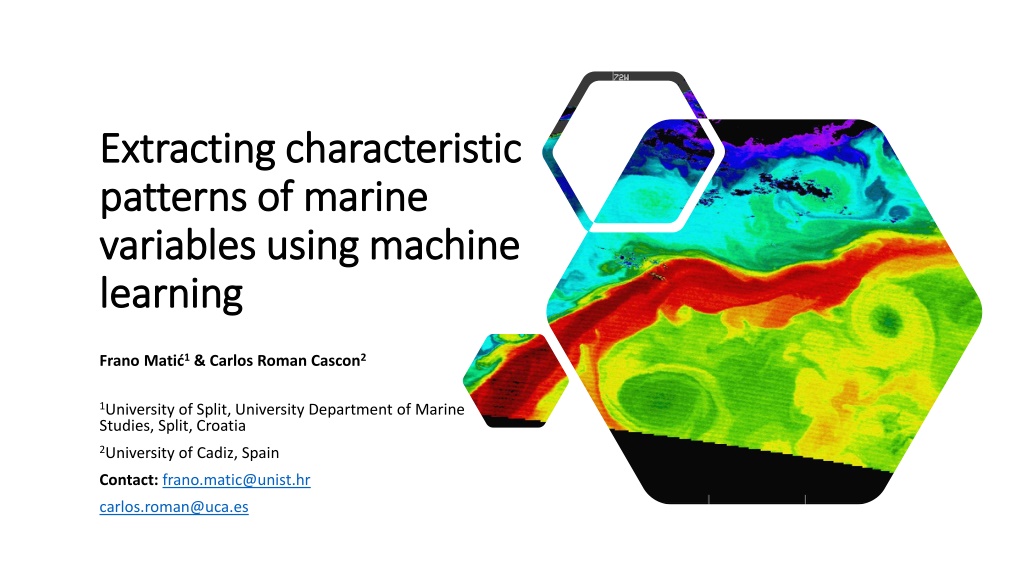Exploring Marine Variables with Machine Learning in the Mediterranean Sea
Discover the characteristic patterns of marine variables using machine learning techniques. Dive into the circulation phenomena of the Ionian Sea and the physical reanalysis dataset of the Mediterranean Sea. Explore tools like Neural Gas for optimal data representations and classifications in marine studies.
Download Presentation

Please find below an Image/Link to download the presentation.
The content on the website is provided AS IS for your information and personal use only. It may not be sold, licensed, or shared on other websites without obtaining consent from the author. Download presentation by click this link. If you encounter any issues during the download, it is possible that the publisher has removed the file from their server.
E N D
Presentation Transcript
Extracting characteristic Extracting characteristic patterns of marine patterns of marine variables using machine variables using machine learning learning Frano Mati 1& Carlos Roman Cascon2 1University of Split, University Department of Marine Studies, Split, Croatia 2University of Cadiz, Spain Contact: frano.matic@unist.hr carlos.roman@uca.es
Motivation Motivation An interesting phenomenon Circulation of the Ionian Sea is either cyclonic or anticyclonic. During cyclonic phase: Warmer and saltier Levantine water enters the Adriatic Sea along the eastern Adriatic coastline During anticyclonic phase: Colder and less salty western Mediterranean water enters the Adriatic Sea Cyclonic and anticyclonic phase interchange with a quasi-decadal periodicity (Batisti et al., CSR, 2019) (Mihanovi et al., FMARS, 2021)
Mediterranean Sea Physics Mediterranean Sea Physics Reanalysis dataset Reanalysis dataset Credits: E.U. Copernicus Marine Service Information INFO: The Med MFC physical reanalysis product is generated by a numerical system composed of an hydrodynamic model, supplied by the Nucleous for European Modelling of the Ocean (NEMO) and a variational data assimilation scheme (OceanVAR) for temperature and salinity vertical profiles and satellite Sea Level Anomaly along track data. The model horizontal grid resolution is 1/24 (ca. 4-5 km) and the unevenly spaced vertical levels are 141.
Mediterranean Sea Physics Reanalysis dataset Mediterranean Sea Physics Reanalysis dataset An easy to understand and easy to use interface for visualization and downloading of necessary data
Neural Gas Neural gas is an artificial neural network inspired by the self-organizing map, introduced in 1991 by Thomas Martinetz and Klaus Schulten. The neural gas is a simple algorithm for finding optimal data representations and can be considered as a one-dimensional reduction/classification method. The main feature is the weak connection (similarity) between the modelled neurons/classes, because during the learning process the algorithm distributes the neurons like a gas in the data space, which makes the method suitable for modelling extreme events. Thomas Martinetz and Klaus Schulten (1991). "A "neural gas" network learns topologies". Artificial Neural Networks. Elsevier. pp. 397 402.
An example of neural gas application Wind over the Mediterranean Sea, January
An example of neural gas application Zoom-in to BMU3
An example of neural gas application Zoom-in to BMU9
Hypothesis Hypothesis The Med MFC physical reanalysis product can reproduce BiOS circulation BiOS circulation influences temperature and salinity distribution in the northern Ionian and the Adriatic Sea
Downloading the selected monthly data from Copernicus Marine Service Basic statistical analysis of the data: monthly and annual means and variability Transformation of the data to fit the Neural Gas method Research steps Research steps Applying the Neural Gas method to the selected data and extracting the characteristic patterns Testing Hypothesis 1 is BiOS reproduced Testing Hypothesis 2 does BiOS influence temperature and salinity distributions in the Adriatic
Requirements Requirements Access to MATLAB
Project mode dynamics Project mode dynamics Meeting with mentors Work in group Suggested timeline Introduction to the Mediterranean Sea Physics Reanalysis dataset Data download 1 week Statistical analysis Basic statistical analysis of relevant variables 2 weeks Transforming data to fit the Neural Gas method 1 week Neural Gas method Applying the neural Gas Method 1 week Extracting characteristic patterns 1 week Presenting characteristic patterns to mentors discussion on approach to confirm/reject hypothesis Research; confirming or rejecting hypothesis 1 week Writing and presenting the final report 2 weeks






















